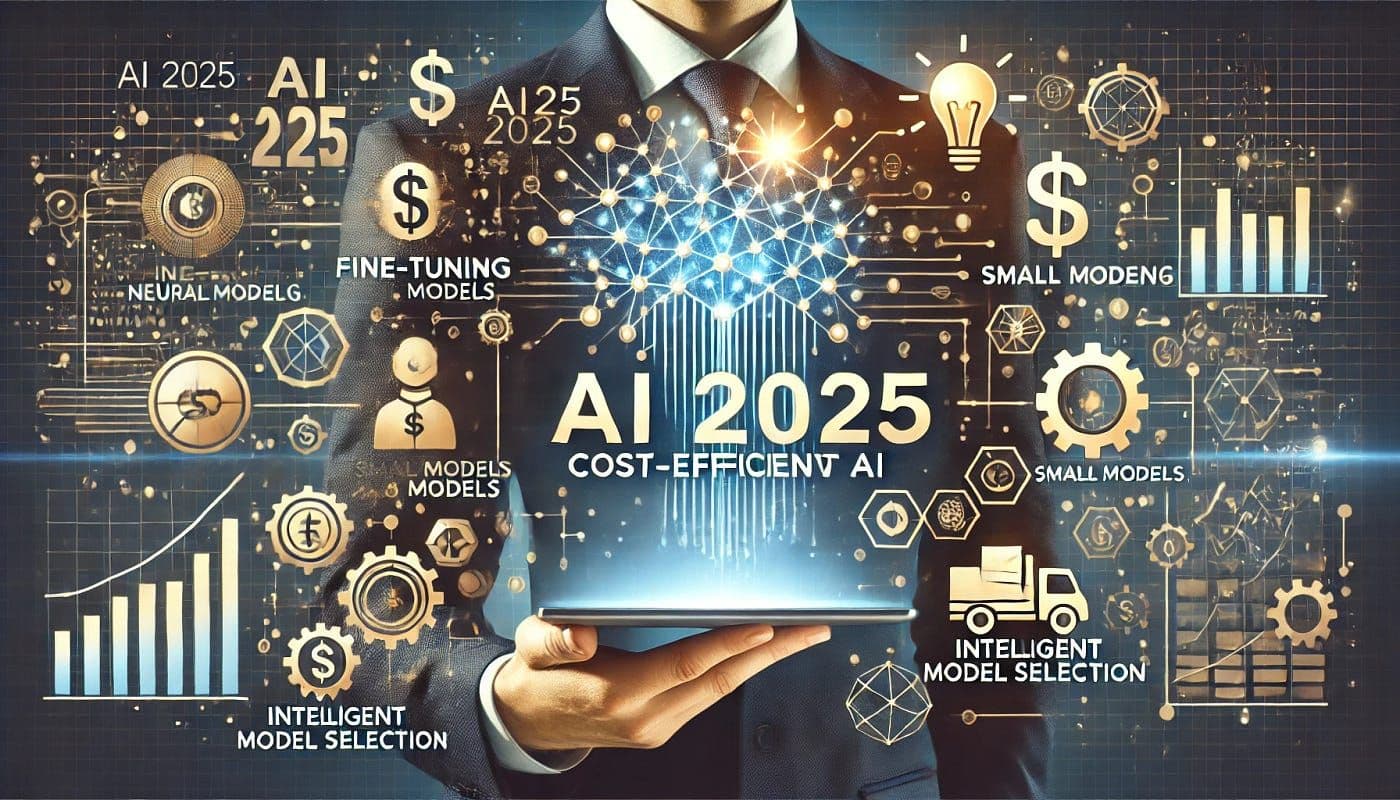
How AI Transforms Your Business in 2025: A Practical Guide
Business has changed dramatically in 2025. AI and machine learning now drive success across every industry. Companies using AI-powered solutions see 40% improvements in efficiency. Those without AI risk falling behind competitors.
This guide shows you how AI transforms modern business operations. You'll discover actionable strategies to gain a competitive edge.
Why AI Matters Now
77% of companies have integrated AI into their core processes by 2025. This isn't optional anymore—it's essential for survival.
Three factors drive this shift:
- Computing costs have dropped dramatically
- More data is available than ever before
- AI tools are now affordable for small businesses
Today's AI does more than automate tasks. It delivers business intelligence, predicts outcomes, and supports smart decisions. Modern systems augment what humans do best rather than simply replacing routine work.
AI-Driven Personalization: What Your Customers Expect
Customers demand personalized experiences in 2025. Generic marketing and one-size-fits-all service no longer work.
How Personalization Works Now
Old systems grouped customers into broad categories. Modern AI treats each customer as unique. It processes thousands of data points instantly to create individual experiences.
Machine learning analyzes:
- How customers behave on your site
- What they've purchased before
- Their social media activity
- The sentiment behind their feedback
These systems learn continuously. Every interaction makes them smarter.
Real-Time Content That Converts
The best personalization systems adjust your website instantly. They change product recommendations, pricing, and messages in milliseconds based on behavior.
Results speak clearly: E-commerce sites using AI personalization see conversion rates jump 25-35% compared to traditional methods.
Smart Communication Across Channels
AI orchestrates sophisticated marketing across email, social media, and messaging. It determines the perfect time to reach each customer, crafts personalized subject lines, and selects the right channel.
Modern chatbots understand context and emotion. They provide support that feels human while handling thousands of conversations simultaneously.
Anticipating Customer Needs
The cutting edge? AI that knows what customers need before they ask.
Predictive models spot when customers need support, plan to buy, or might cancel. Subscription services predict when you'll need refills. Banks anticipate cash flow problems and offer solutions proactively.
Privacy Matters
As personalization grows stronger, privacy concerns grow too. Leading companies in 2025 balance effectiveness with protection.
Transparent data practices build trust. Customers want personalized experiences, but they also want control over their information.
Predictive Analytics: Smarter Business Decisions
Machine learning transforms how businesses make decisions. Instead of reacting to problems, you anticipate them. Instead of guessing, you know.
The Power of Prediction
Machine learning spots patterns in massive datasets that humans miss completely. Train models on historical data, and you gain predictive power across every business function.
Forecasting accuracy improves 20-30% after implementing ML-powered analytics. That translates directly to better decisions and higher profits.
Supply Chain Revolution
Machine learning predicts demand by analyzing:
- Historical sales patterns
- Seasonal trends and weather
- Economic indicators
- Social media buzz
- Competitor moves
Retailers optimize inventory across thousands of products. They reduce stock outs by 35% while cutting excess inventory costs. Manufacturers predict equipment failures before they happen, preventing costly downtime.
Keep Your Best Customers
Understanding customer lifetime value changes everything. ML models analyze hundreds of variables to predict which customers will generate the most value.
Churn prediction identifies at-risk customers weeks before they leave. Proactive intervention through personalized offers saves relationships. Companies report retention improvements of 15-25%.
Financial Intelligence
Banks use ML for credit risk, fraud detection, and market prediction. These models process alternative data beyond credit scores, enabling fairer lending while maintaining accuracy.
Finance teams forecast cash flow, optimize budgets, and plan scenarios automatically. Systems adjust forecasts based on real-time performance and market conditions.
Dynamic Pricing That Works
Airlines pioneered dynamic pricing decades ago. Now ML brings sophisticated pricing to businesses of all sizes.
Algorithms analyze demand, competition, and customer willingness to pay. They recommend optimal prices in real-time, balancing revenue with customer satisfaction.
HR That Predicts Success
HR departments leverage analytics for hiring, retention, and planning. ML identifies which candidates will succeed in specific roles and predicts turnover risk.
These capabilities enable strategic talent decisions that align with business goals.
AI Agents: The New Workforce
AI agents represent the biggest operational shift in 2025. Unlike rigid automation, these agents think, adapt, and make decisions.
How AI Agents Work
Modern agents combine language models, reinforcement learning, and workflow engines. They understand context, decide with incomplete information, and adapt based on results.
These systems remember past interactions, plan complex tasks, and use software tools independently.
Automation That Thinks
Traditional automation needed explicit programming for every step. AI agents understand objectives and adapt to changes.
Organizations deploy agents for invoice processing, expense management, and customer onboarding. These agents handle exceptions intelligently, escalating only unusual situations to humans.
The impact? Companies report 50-70% reductions in processing time with accuracy exceeding human performance.
Smart Scheduling
AI agents analyze workload patterns, deadlines, and resources to optimize scheduling. They learn individual working styles and make personalized recommendations.
Project management platforms automatically reassign tasks when bottlenecks emerge and identify risks before they impact timelines.
Multiple Agents Working Together
The cutting edge involves specialized agents collaborating on complex goals. In customer service, separate agents handle intent, knowledge, response, and sentiment—each optimizing while coordinating seamlessly.
Development teams employ coding agents, testing agents, and documentation agents. These systems amplify productivity while improving quality.
Agents as Decision Support
Beyond automation, AI agents assist human decision-making. They analyze situations, present data, identify options, and make recommendations.
Executives use agents to gather competitive intelligence, analyze trends, model scenarios, and synthesize insights automatically.
Keeping Control
As agents gain autonomy, governance matters. Leading companies define appropriate autonomy levels, establish oversight for critical decisions, and create audit trails.
Explainable AI builds trust by clarifying why agents make specific decisions.
Natural Language Processing: Talk to Your Software
NLP has transformed from research to reality. Computers now understand, interpret, and generate human language naturally.
Interfaces That Understand You
Old software required learning commands and navigating complex menus. NLP-powered interfaces understand natural language and respond conversationally.
Voice assistants and chatbots now grasp context, handle ambiguous questions, and generate fluent responses. Users interact with enterprise software using everyday language.
Processing Documents Automatically
Businesses handle enormous volumes of text—contracts, emails, feedback, reports. NLP extracts key information, classifies documents, identifies entities, and generates summaries automatically.
Legal teams review contracts and identify risks. Financial analysts extract insights from earnings calls. Customer service teams analyze tickets to spot product issues.
Search That Actually Works
Traditional search fails when you can't formulate the exact query. Semantic search understands meaning behind queries and retrieves conceptually relevant results.
Enterprise systems leverage NLP to organize documentation automatically and generate knowledge articles from support conversations. Employees spend less time searching for information.
Understanding Customer Sentiment
NLP processes reviews, social media, and support interactions at scale. It quantifies satisfaction, identifies pain points, and tracks brand perception.
Aspect-based analysis identifies specific features driving sentiment. This insight guides product development and experience improvements.
Real-time monitoring enables rapid response to emerging issues before they escalate.
AI-Powered Coding
The most dramatic application? Coding assistants that understand natural language descriptions and generate functional code.
Developers describe desired functionality in plain English. NLP models produce implementation code in the appropriate language. This accelerates development and lowers barriers for less experienced developers.
Breaking Language Barriers
NLP-powered translation reaches near-human quality. Businesses deploy software globally without massive localization costs.
Real-time translation lets users interact in their preferred language regardless of original content language. Advanced systems culturally adapt content for different regions.
Content Creation Support
Generative AI assists with marketing, documentation, and reporting. Systems generate product descriptions, social media posts, and email campaigns from brief prompts.
Human oversight remains essential, but AI-assisted creation accelerates workflows dramatically while ensuring consistency.
AI-Powered Data Analysis: From Numbers to Action
Data volume explodes while insight remains scarce. AI-powered analysis transforms complexity into clarity.
Automated Data Preparation
Data scientists historically spent 60-80% of their time cleaning data. AI automates this tedious work through intelligent algorithms that identify quality issues and execute transformations.
ML models detect anomalous patterns indicating errors or inconsistencies, dramatically improving quality while reducing manual effort.
Pattern Recognition That Sees Everything
AI identifies subtle patterns in complex data that humans cannot perceive. Deep learning analyzes time series, transactions, and behavioral logs to detect opportunities and risks.
Anomaly detection monitors processes, network traffic, and transactions to identify unusual patterns indicating fraud, breaches, or failures.
Manufacturers detect defects with greater accuracy than human inspectors. Banks identify fraudulent transactions in real-time.
Exploring Data Automatically
Modern AI doesn't just answer questions—it explores data to identify interesting patterns and generate hypotheses.
Automated exploratory analysis examines datasets from multiple perspectives, testing thousands of relationships and highlighting significant findings.
These tools democratize data science, enabling business users without statistical expertise to uncover insights.
Understanding Cause and Effect
Correlation reveals relationships, but decisions require understanding causation—what drives outcomes.
AI-powered causal inference estimates causal relationships from data. Marketing teams determine which campaigns drive sales versus coincidental correlations. Product teams assess whether feature changes cause engagement improvements.
Real-Time Insights
Business moves fast, requiring analytics that process data instantly. AI stream processing platforms analyze continuous flows from IoT devices, clickstreams, and operational systems.
Real-time analytics enable dynamic pricing, immediate fraud intervention, and rapid operational responses. Systems process millions of events per second.
Reports That Tell Stories
Executives need narratives explaining what data means and why it matters. AI reporting systems generate written analyses highlighting trends, explaining anomalies, and recommending actions automatically.
Natural language generation transforms metrics into compelling stories tailored to different audiences.
Empowering Everyone
Augmented analytics platforms embed AI assistance throughout analysis workflows. They guide users, recommend techniques, select optimal visualizations, and interpret results.
This democratizes analysis capabilities, empowering domain experts to leverage data without advanced statistical training.
How to Implement AI Successfully
Integrating AI requires thoughtful strategy beyond simply buying technology.
Build Your Foundation
AI systems need quality data. Invest in infrastructure ensuring data quality, accessibility, and governance. Implement data warehouses, establish quality standards, and build pipelines delivering clean data reliably.
Cultivate a data-driven culture valuing experimentation and continuous learning. Leadership must champion AI initiatives and ensure cross-functional collaboration.
Choose the Right Projects
Not every process benefits equally from AI. Prioritize use cases offering substantial ROI, aligning with strategy, and presenting manageable complexity.
High-value cases involve clear success metrics, abundant training data, significant business impact, and tolerance for gradual improvements. Start with focused pilots demonstrating value.
Build or Buy?
Mature AI platforms mean you rarely develop everything from scratch. Strategic decisions about building versus buying impact success, cost, and speed.
Purchase commodity capabilities like basic chatbots or standard analytics. Build competitive differentiators and proprietary algorithms leveraging unique data.
Many organizations adopt hybrid approaches, leveraging cloud services for infrastructure while building custom applications.
Develop Your Team
AI requires diverse skills—data science, engineering, software development, and domain expertise. Few organizations possess all capabilities internally.
Upskill existing employees through training. Partner with universities or consultancies. Use managed AI services to bridge gaps. Create cross-functional teams combining technical expertise with business knowledge.
Govern Responsibly
As AI assumes decision-making authority, implement governance ensuring ethical, fair, and transparent operations.
Establish review processes for AI projects. Define acceptable use cases. Implement bias detection and mitigation. Create accountability structures.
Regular audits, explain ability mechanisms, and human oversight for high-stakes decisions build trust and ensure responsible AI.
Measure Results
Demonstrate clear business value to justify ongoing investment. Establish metrics connecting AI to business outcomes—revenue impact, cost reduction, customer satisfaction, efficiency.
AI requires continuous monitoring and improvement. Implement MLOps practices automating retraining, monitoring, and deployment to maintain value.
The Competitive Reality
The business landscape of 2025 splits into AI-powered organizations versus those using legacy approaches. This gap translates directly into competitive advantage.
Companies embracing AI report:
- Faster decision-making
- More accurate forecasts
- Superior customer experiences
- Lower operational costs
- Increased innovation capacity
These advantages compound over time, creating performance gaps that become increasingly difficult to close.
The Good News
AI technologies have matured significantly. Implementation barriers have lowered. Cloud platforms democratize access to sophisticated capabilities. Abundant educational resources accelerate learning.
The question isn't whether to adopt AI—it's how quickly you can integrate these technologies responsibly.
Your Next Steps
AI and machine learning have fundamentally transformed business in 2025. Every function—from customer engagement to strategic planning—benefits from intelligent systems.
Thriving organizations view AI as a core operational capability that evolves continuously, not a one-time technology project.
The Journey Ahead
This journey requires:
- Investment in technology and talent
- Commitment to data quality and governance
- Willingness to experiment and learn from failures
- Cultural transformation toward data-driven decisions
The competitive advantages make this journey essential for long-term viability.
Start Now
As AI capabilities advance rapidly, early adopters position themselves to capitalize on emerging opportunities while building organizational capabilities that compound over time.
The most successful companies thoughtfully integrate AI to augment human capabilities, creating hybrid organizations where artificial and human intelligence work together synergistically.
The transformation is underway. Will your organization lead the change or struggle to catch up?
The time to embrace AI-powered operations is now.



